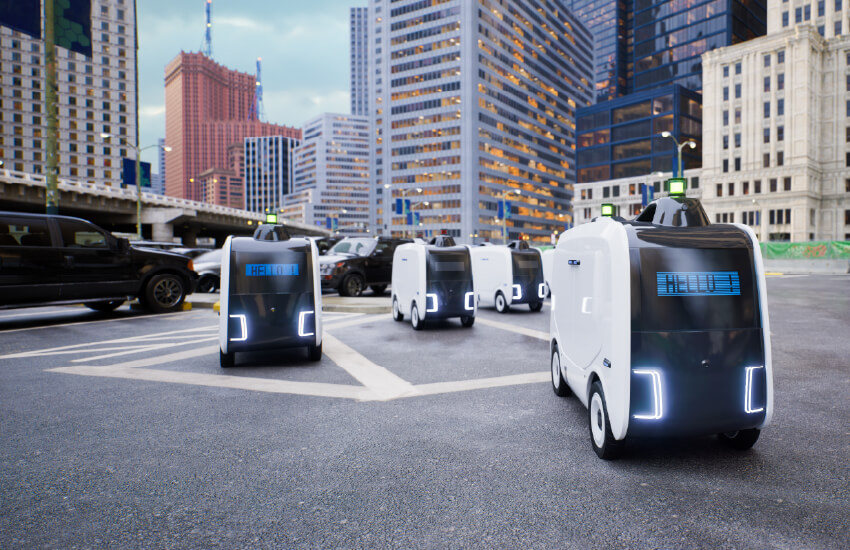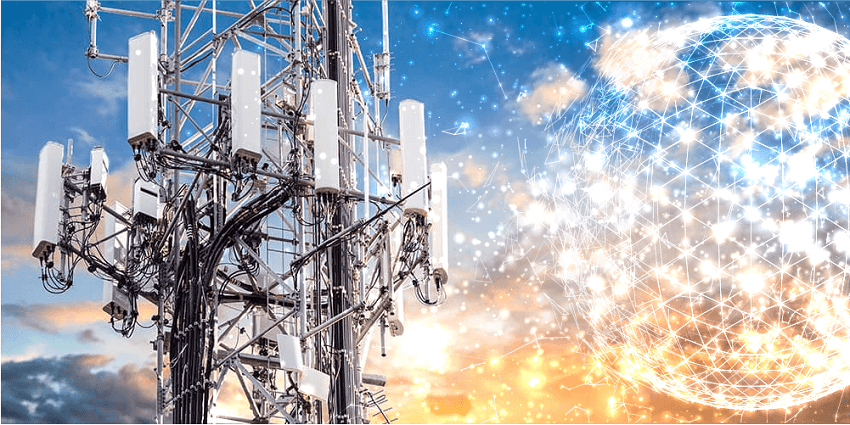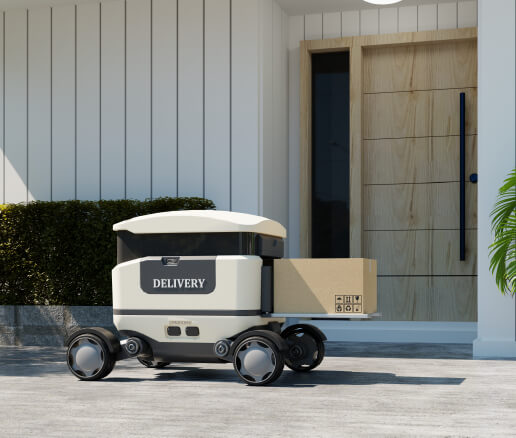by Webbing Team
While we’ve already discussed cellular connectivity in modern supply chains, we’ve only briefly touched on its role in last-mile delivery services. Delivering goods from local hubs to customers’ doors remains the most expensive and logistically complex part of the supply chain. According to industry reports, last-mile expenses account for approximately 53% of total delivery costs. With rising demand for fast deliveries driven by e-commerce growth and labor shortages, the so-called “last mile problem” in logistics persists.
Cellular connectivity plays an important role in addressing this challenge, impacting it in many ways. Over the past two decades, cellular technology contributed significantly to the logistics industry’s digital transformation, enabling real-time tracking and remote management. Before cellular networks were widely integrated, delivery operations relied on manual coordination and paper maps. Delivery was slower, less reliable, and much harder to scale. Today, logistics companies can monitor the exact location of their fleets and optimize routes dynamically. Moreover, they can update customers with accurate delivery times. Thus, cellular technology helps to improve both operational efficiency and customer satisfaction.
Besides that, cellular connectivity was a major driver behind the rise of autonomous delivery solutions: delivery drones, sidewalk robots, self-driving vans etc. Since autonomous systems depend on continuous communication with control centers to receive instructions and transmit data, they need reliable 4G and 5G networks to safely operate across cities.
In addition, by enabling all these new methods of delivery, cellular connectivity supported sustainability goals – robots and drones offer lower environmental impact compared to traditional trucks or cars.
To better understand the importance of cellular technology in this context, let’s take a look at the use cases:

Motorbikes and Bicycle Couriers
One of the clearest examples of how indispensable cellular connectivity is to last-mile delivery is its use by couriers on motorbikes and bicycles. Apps like Uber Eats, DoorDash, and courier platforms rely heavily on cellular networks to maintain live updates between dispatchers, couriers, and customers. This connectivity ensures fast handoffs and supports live ETA tracking. For bicycle couriers, cellular-enabled devices offer cycling-optimized delivery apps, where riders receive turn-by-turn directions and updated delivery queues.
Drone Deliveries
While the concept dates back over a decade, real-world drone delivery began taking shape around 2016, with broader adoption and commercial use picking up in the early 2020s. Today, delivery drones are becoming commonplace all around the world, including grocery shopping, restaurant orders, medical deliveries and postal services. Although stringent regulatory requirements slowed down the scaling up of drone delivery networks, progress is being made, and multiple companies have received waivers or certifications to operate in specific regions. Drones also allow for optimizing existing procedures and making them faster and more efficient, like having medicines flown to seafarers who fall sick or delivering defibrillators faster than the ambulance car. All these drones need to use mobile networks for command and control functions when performing their tasks.

Delivery Robots and Autonomous Vehicles
Delivery robots emerged to solve the last-mile challenge. They reduce reliance on human couriers and lower carbon emissions. Also, some of them operate efficiently even on sidewalks and campus paths, which makes them ideal for short-range urban and suburban deliveries.
Sidewalk robots use cellular connectivity to maintain real-time communication with remote operators and backend systems. This connection allows them to transmit high-quality video and system diagnostics while receiving navigation commands. There are also larger-sized autonomous ground vehicles (AGV), that need cellular connectivity for mapping and remote assistance.
Cellular connectivity is essential for remote supervision and teleoperation. If a robot or AGV encounters a complex situation, a human operator can step in and take control remotely. All communications between the robots and the operator rely on public cellular networks.
Smart Lockers and Pickup Stations
With the boom in e-commerce, smart lockers in apartment buildings, offices and public spaces were a response to the growing demand for secure and convenient delivery options. They were a scalable way to handle high parcel volumes without increasing delivery failures, providing 24/7 access points where couriers could deposit packages and customers could retrieve them at their convenience. Their popularity surged during the COVID-19 pandemic, when minimizing in-person contact became a top priority.
To operate effectively in various locations, especially outdoor or remote sites, smart lockers need cellular connectivity. Through 4G or 5G networks, they communicate with backend systems to receive delivery instructions and send pickup codes to customers, or, if needed, report usage or maintenance issues in real time. Cellular connections make these lockers location-independent, enabling deployment in areas without Wi-Fi or wired internet, and allowing for remote diagnostics and firmware updates, which reduces the need for on-site servicing.

Connectivity Requirements for Last-Mile Delivery
With many cellular connectivity applications, the requirements may vary greatly, but some are common to all use cases.
Coverage
Uninterrupted connectivity is crucial. When it’s a delivery driver navigating city streets or a cyclist using a routing app, failure to connect may result in a delay. With autonomous robots and especially with drones, poor coverage can lead to failed deliveries, and even safety risks. That’s why reliable coverage and seamless signal handoffs between network zones are key to supporting efficient and dependable last-mile operations.
Seamless Connectivity
Delivery services often cross between multiple network zones or providers, particularly in large metro areas or across borders. Seamless network handoffs ensure there’s no disruption when moving between towers or switching networks. This is especially important for services using multi-carrier connectivity to maintain consistent uptime.
Latency
Latency is important in last-mile delivery because it determines how quickly data can travel between devices and servers. That will determine how fast couriers and dispatchers can respond to events. Low latency ensures that GPS tracking is accurate in real time, customers get up-to-date ETAs, and route adjustments happen instantly. For autonomous delivery systems like drones and robots, low latency is even more critical, as delayed commands or video feeds can lead to navigation errors or safety risks. For all use cases involving moving vehicles, drones or robots, a millisecond delay can literally lead to catastrophic consequences. Cellular connectivity can provide better latency compared to other connectivity methods, but it should be noted that technically, latency depends on the architecture of your provider’s core network and may vary significantly.
Bandwidth
High bandwidth allows for the smooth transfer of large amounts of data. It can be high-resolution video from drones, live tracking information, route updates, and customer communications, or all at the same time. This is especially critical when managing multiple deliveries across a busy network. Without sufficient bandwidth, data can bottleneck, which will negatively affect delivery speed and customer experience.

Webbing’s Connectivity Solution for Last-Mile Delivery
Webbing offers a connectivity solution that ensures global access to reliable and high-quality internet, with low latency and the best of class coverage. It provides secure and continuous internet connection for all types of devices used by delivery companies, wherever and whenever they need it.
Webbing’s partner network of over 600 mobile operators worldwide guarantees global coverage. It allows to roam on several carriers’ network in every region, solving the problem of weak spots that any mobile network may have and ensuring full coverage and continuous connectivity even at remote locations.
Webbing is a global connectivity provider with a distributed full core network with local breakouts, multiple network solution, and data server redundancy that provides connectivity stability and low latency. As such, Webbing’s network allows for the realization of the most complex scenarios with different types of devices, high-data consumption and industry-specific requirements.
Our eSIM solution guarantees failover connectivity with the capability of using multiple mobile carrier profiles, easily changing carriers at any time with zero integration, and an option to fall back from a failing profile to a different profile without any need to communicate with a remote server or deal with multiple SIM cards. Easily set business rules help determine automatic profile allocation based on location and enable fallback mechanisms in case of coverage issues.
A flexible approach to data packages allows us to tailor our connectivity offering for every customer based on the type of connected devices and their data consumption needs as well as the locations where the devices are used, aiming at overall optimization of the total cost of operations for the client.
Our solutions help logistics and retail companies and delivery operators overcome their connectivity challenges and optimize costs for global IoT deployments, providing the benefits of roaming with multiple carrier options in every region, and seamless transition between carriers, while maintaining low rates and low latency on a global scale with a single SIM.
Reach out today to learn more about Webbing’s customized connectivity solutions for last-mile delivery.




